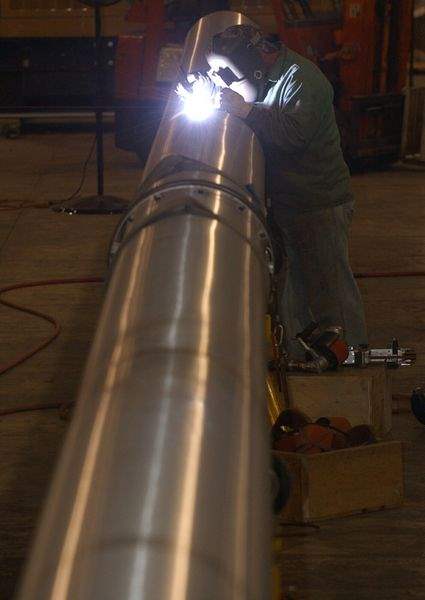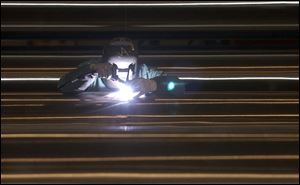
Welders put a shine to new bridge
4/25/2005
Fru-Con Construction employee Dave Digby works on a stainless steel cable sheathing.
blade / king

Jim Adams smooths out a weld on the stainless steel covering that will sheath the cable stays that will help hold up the I-280 bridge over the Maumee River. The pipes are being welded in sections at an off-site warehouse and will be trucked to the bridge for assembly and additional welding.
One of the brightest signature elements of Toledo's new I-280 bridge over the Maumee River is beginning to come together inside a nondescript warehouse in Oregon.
There, a small team of ironworkers is welding sections of stainless-steel pipe together to make larger pieces of what eventually will be the light-reflecting sheaths on the Veterans' Glass City Skyway's stay cables.
It's a very precise operation, because once installed on the bridge, project officials don't want the sheaths, which also serve to protect the cables from the weather, to look like anything other than continuous stainless steel - a goal that has both aesthetic and engineering benefits.
The two longest sheaths will be about 606 feet, requiring 20 or more welds each when finished. The six shortest stays will use 18-inch-diameter sheaths that come in 35-foot sections, while the other 14 will have 20-inch-diameter sheaths that come in 28-foot, 2-inch sections.
Each stay will have two sheaths, one on either side of the bridge's central pylon.

Fru-Con Construction employee Dave Digby works on a stainless steel cable sheathing.
Overall, about 444 welds will be made to put all the sheaths together, with a total sheathing length of about 13,300 feet.
Some of the welds will be made up on the bridge itself, because 105 feet is as long as the sections can be and still be trucked to the construction site about four miles away.
The field welding is not a job Jim Adams is particularly looking forward to, as the stay and sheath installation is expected to start this fall and continue into winter. Right now, his primary job is polishing the welds inside the warehouse, but he said he may be involved with the installation when it starts.
"I'll be sweating in here this summer, and freezing out there next winter," Mr. Adams, an ironworker from West Toledo, said last week.
But he recognizes his handiwork will be on display for all to see as the bridge is built, and that he'll be able to tell relatives and friends he was a part of it.
"It'll be nice to say that," Mr. Adams said.
For now, he and his colleagues do their work on fit-up tables that are, in essence, rows of padded frames to support the big shiny pipes at waist level while they're welded and polished.
After protective plastic wrappings are removed from the sections, backer plates designed to fit inside the joints are spot-welded into place to hold neighboring sections in alignment while workers use an orbital arc welder to make the main weld. The machine travels on a raised track around the sections, welding one half at a time and making two passes on each half using a stitching pattern, said Brett Morris, a project inspector for the Ohio Department of Transportation.
Tolerances are tight. The sheaths' straightness may vary by just half an inch over 20 feet, Mr. Morris said. Straightness is checked the old-fashioned way, with a string-line, because there's nothing to which a laser leveler can be attached.
And the welds are checked for voids or cracks using a red dye solution that is allowed to soak in, then gently wiped clean. A white developer is then sprayed on the weld to reveal any of the indicator dye that would remain in an imperfection.
Once inspected, the welded sheath section is moved to another stand for grinding and polishing, to remove any excess flux and create a matching finish. The final step is an electrical polishing called passivation that removes any contaminants that may have been left on the stainless surface during welding - contaminants that could otherwise cause the sheath to rust.
The sheaths are just 3/16ths of an inch thick, but that will be enough to shield the stay cables inside from the elements and to provide a reflective surface for lights that will shine on them from the bridge's deck.
The stays will be composed of as many as 156 seven-strand steel cables coated with epoxy threaded parallel to each other up from the deck on one side of the bridge, through the pylon, and back down to the deck on the other side.
Everything will be grounded electrically to eliminate the chance for storm damage or interaction between the metals. Mike Gramza, ODOT's construction manager for the bridge project, said individual cables will be removable for inspection, as each stay will have a few extra cables to provide redundancy.
All of the cables, anchors, and other devices needed for the stays are stored in the warehouse awaiting installation. The transportation department bought the materials early on in the project, so that everything could be inspected and tested with plenty of time left over to procure replacements if problems arose, Mr. Gramza said.
The materials cost $7.8 million, a cost not factored into the $220 million contract the state has with Fru-Con Construction Co., of Ballwin, Mo., to build the bridge. Mr. Gramza noted that had the sheathing and cables been included in the construction contract, they might have ended up costing twice as much because of the rising price of steel. The early purchase also eliminated the risk of construction delays because of any supply problems, he said.
Construction of the bridge's main line spans has been on hold since a Feb. 16, 2004, crane collapse that killed four workers and injured four others. Fru-Con expects to resume that part of the work within about two months using several other cranes.
The southern half of the main span will be supported by temporary piers during construction; once that half is finished, the northern half, which spans the river's shipping channel, will be built in cantilever fashion with the stay cables strung through the pylon to hold it up. All construction is scheduled for completion by October, 2006.
Contact David Patch at:
dpatch@theblade.com
or 419-724-6094.